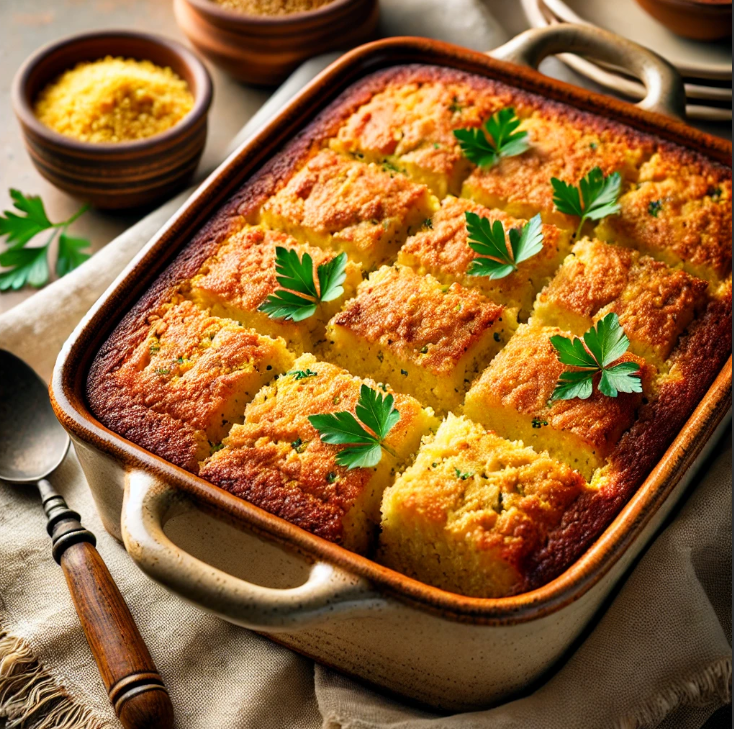When it comes to crowd-pleasing side dishes, cornbread pudding reigns supreme. This creamy, sweet-savory dish blends the comforting flavors of cornbread with the richness of custard, creating a texture that’s both soft and slightly crisp. Whether served alongside roasted turkey during the holidays or as a cozy addition to weeknight dinners, cornbread pudding is a versatile favorite that never disappoints.
In this article, we’ll dive into everything you need to know about cornbread pudding—its origins, key ingredients, variations, and how to make it at home. Plus, we’ll share pairing ideas, answer common questions, and offer creative twists to help you elevate this classic dish.
Table of Contents
What Is Cornbread Pudding?
Defining Cornbread Pudding
At its core, cornbread pudding is a rich, baked dish that combines cornbread mix, sweet corn, and creamy ingredients like sour cream and butter. The result is a casserole-like side that’s moist, flavorful, and satisfying. Unlike traditional cornbread, which is often crumbly, cornbread pudding has a custard-like texture that melts in your mouth.
Why It’s a Favorite for Gatherings
There’s a reason cornbread pudding has become a staple at holiday dinners and potlucks. It’s easy to make, requires minimal ingredients, and pairs well with almost any main dish—from barbecue ribs to roasted chicken. Its balance of sweet and savory flavors makes it a hit with both kids and adults. Plus, its simplicity means you can dress it up with add-ins like cheese, bacon, or jalapeños, giving it a personal touch.
Whether you’re serving it as a Thanksgiving side or a comforting dish on a cold night, it has a way of bringing people together around the table.
History and Origins of Cornbread Pudding
Southern Roots of Cornbread
The story of it begins with cornbread, a staple of Southern cuisine with deep historical roots. Cornbread’s origins can be traced back to Indigenous peoples, who used ground cornmeal to create simple bread-like dishes. When settlers adopted this tradition, cornbread evolved into a beloved comfort food across the South. Over time, cooks began experimenting with ways to make cornbread more moist and indulgent, leading to the creation of cornbread pudding.
Adaptations Over Time
As Southern cooks passed down their recipes, it became a blank canvas for regional and family variations. In some households, the dish leaned savory, incorporating ingredients like cheese, green onions, and spices. In others, it took on a sweeter profile, with the addition of sugar, honey, or even fruit.
What sets cornbread pudding apart is its ability to adapt to different tastes and occasions. Whether it’s baked as a Thanksgiving side dish or a weeknight casserole, its rich, creamy texture has made it a timeless favorite in kitchens across the United States.
Essential Ingredients for Cornbread Pudding
Cornbread Base
The foundation of cornbread pudding is, of course, cornbread. You can start with homemade cornbread or save time by using a boxed mix like Jiffy. While both options work, boxed mixes often provide a slightly sweeter flavor that complements the creamy custard. If you’re making cornbread from scratch, adding a touch of sugar can help achieve the perfect balance of sweet and savory.
Dairy Additions for Creaminess
To give it its signature richness, dairy ingredients are key. Sour cream is a popular choice, as it adds tanginess and a velvety texture. Butter, often melted and folded into the batter, brings depth and flavor. Cream-style corn is another essential ingredient, providing moisture and natural sweetness that complements the cornbread base.
Optional Add-Ins
For those who love to experiment, it offers endless opportunities for customization. Add cooked bacon or shredded cheddar for a savory twist, or mix in jalapeños for a kick of spice. For a sweet variation, consider folding in dried cranberries, raisins, or a drizzle of honey.
With these simple ingredients and endless possibilities, it can be tailored to suit any meal or occasion.
How to Make Cornbread Pudding
Preparation Steps
Creating the perfect cornbread pudding begins with combining the right ingredients. First, preheat your oven to 350°F (175°C). In a large bowl, mix a box of cornbread mix (or homemade cornbread batter) with cream-style corn, sour cream, melted butter, and eggs. These ingredients create a creamy texture and rich flavor.
If you prefer a slightly sweet version, you can add a tablespoon of sugar or honey to the mix. For those who lean toward savory flavors, diced jalapeños, shredded cheese, or crumbled bacon make fantastic add-ins.
Once your batter is ready, pour it into a greased baking dish. A glass or ceramic dish works best, as it evenly distributes heat for a golden crust and soft interior.
Baking Tips
Bake the pudding in the preheated oven for about 40–45 minutes. The top should be lightly golden and slightly firm to the touch. You can insert a toothpick into the center to check for doneness—if it comes out clean or with just a few moist crumbs, your pudding is ready.
For a crispy top, consider sprinkling a little shredded cheese on top during the final 10 minutes of baking. Let the dish cool slightly before serving to allow the pudding to set.
Variations of Cornbread Pudding
Savory Cornbread Pudding
For a heartier, savory version, focus on bold flavors. Adding sharp cheddar cheese, green onions, or cooked sausage to the batter creates a meal-worthy dish. You can also mix in chopped bell peppers or fresh herbs like thyme for an extra layer of flavor. This variation pairs beautifully with barbecue or roasted vegetables.
Sweet Cornbread Pudding
If you have a sweet tooth, transform it into a dessert by adding sugar, honey, or maple syrup to the mix. Fold in ingredients like dried cranberries, raisins, or fresh blueberries for bursts of sweetness. A dusting of cinnamon or nutmeg over the top before baking adds warmth and aroma.
No matter which variation you choose, it is endlessly versatile and guaranteed to please any crowd.
For a twist on cornbread recipes, check out the Sweet Potato Cornbread Recipe.
Perfect Pairings for Cornbread Pudding
Classic Southern Dishes
When serving it, pairing it with classic Southern dishes elevates the meal to a whole new level. Fried chicken, for instance, is a natural fit, as its crispy exterior complements the creamy texture of the pudding. Another timeless option is barbecue ribs or pulled pork, with the smoky, tangy flavors of the meat balancing the sweet-savory notes of the pudding.
Collard greens or sautéed green beans are also excellent side dishes. Their freshness provides a contrast to the richness of cornbread pudding, creating a harmonious balance on the plate.
Seasonal and Holiday Pairings
During the holiday season, it shines as a side dish alongside roasted turkey or glazed ham. Its comforting flavors make it a welcome addition to any Thanksgiving or Christmas spread. For a summer barbecue, pair it with grilled corn on the cob or smoked sausages to keep the meal light yet satisfying.
No matter the season, it pairs beautifully with almost any main dish, making it a versatile crowd-pleaser.
FAQs About Cornbread Pudding
Is it the Same as Corn Casserole?
While they share similarities, cornbread pudding and corn casserole are slightly different. Corn casserole is typically denser and more bread-like, whereas cornbread pudding has a creamier, custard-like texture. Both are delicious, but cornbread pudding often has a richer, more indulgent flavor.
Can I Make it Ahead of Time?
Yes, you can prepare it ahead of time! Mix the ingredients and store them in the refrigerator, covered, for up to 24 hours. When ready to bake, let the dish sit at room temperature for 15 minutes before placing it in the oven.
What’s the Best Way to Reheat it?
To reheat leftovers, cover the dish with foil and warm it in the oven at 300°F for 10–15 minutes. This method helps maintain the creamy texture without drying it out.
Can it Be Frozen?
Yes, you can freeze it. Let it cool completely, then wrap it tightly in plastic wrap and aluminum foil before freezing. Thaw it in the refrigerator overnight before reheating.
Final Thoughts: Why It Is a Must-Try
A Dish That Combines Comfort and Versatility
Few dishes bring comfort and versatility to the table like cornbread pudding. Its creamy texture, sweet-savory flavor, and ability to pair with countless main dishes make it a standout choice for any occasion. Whether it’s a cozy family dinner, a holiday feast, or a potluck with friends, cornbread pudding always delivers.
Encouragement to Experiment
What makes it even more special is how easy it is to customize. From adding cheese and jalapeños for a savory twist to incorporating fruits and spices for a sweet treat, the possibilities are endless. By experimenting with different ingredients and pairings, you can make this classic dish uniquely your own.
With its blend of tradition and creativity, it deserves a spot in your recipe collection. It’s a dish you’ll return to time and again, delighting both you and your guests.
If you love experimenting with unique textures and flavors, you could also try the Blackberry Cobbler with Cake Mix, which offers a quick and satisfying dessert option.
Creative Variations for Cornbread Pudding
Sweet Cornbread Pudding Variations
If you’re craving a dessert-like twist on it, there are plenty of options to explore. Add a touch of cinnamon, nutmeg, or vanilla extract to the batter for a warm, aromatic flavor. Dried fruits like raisins, cranberries, or apricots provide bursts of sweetness, while a drizzle of maple syrup or honey over the top adds a luscious finish.
For an indulgent touch, fold in white chocolate chips or top the pudding with a layer of caramel sauce before baking. These sweet variations transform cornbread pudding into a standout dessert.
Savory Cornbread Pudding Ideas
On the savory side, it becomes a heartier dish with the addition of bold ingredients. Stir in cooked sausage, crumbled bacon, or diced ham for a meaty upgrade. Roasted vegetables like bell peppers, onions, or zucchini add color and depth of flavor.
For a spicy kick, mix in jalapeños, chili flakes, or even a dash of hot sauce. These savory variations make cornbread pudding perfect as a side dish or even a main course.
With so many creative ways to prepare cornbread pudding, you’ll never run out of ideas to keep this classic dish fresh and exciting.
For more creative ways to make Cornbread Pudding and explore variations on this classic dish, visit Food Network. Their collection of recipes and expert tips will inspire you to perfect this comforting favorite!



15 thoughts on “Cornbread Pudding: The Ultimate Comfort Food”